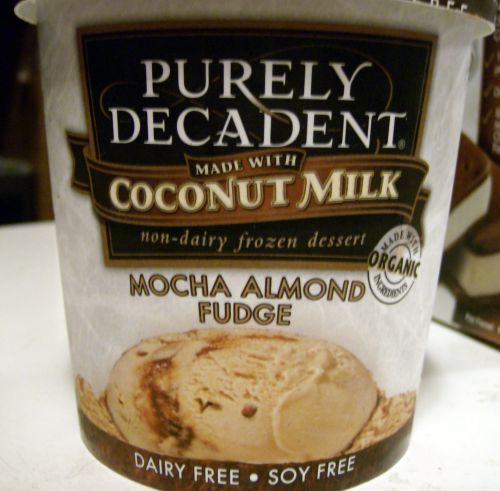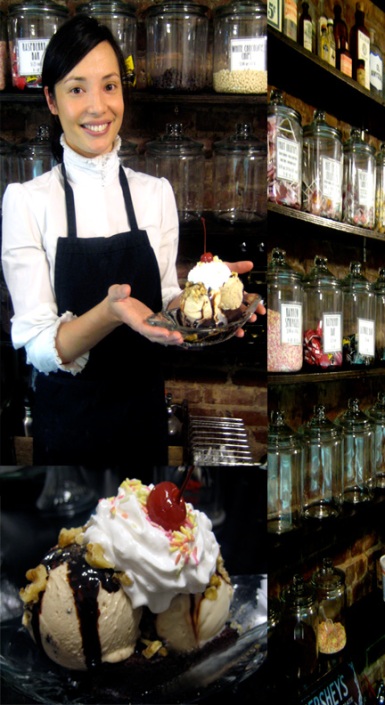This blog may get some people’s panties in a bunch and cause some controversy, but it’s time to get honest about dairy. What’s cold, sweet, healthy, delicious, and doesn’t come from the nipple of a tortured animal? Why vegan ice cream, of course. As information on the dairy industry continues to repulse, sadden, and scare us – vegan ice cream is the best option to satisfy our oh-so-sweet tooth. Before you yelp; “But, GirlieGirl, I don’t do soy!!” Chillax! The new vegan ice cream options are better for you than ever – as many are now COCONUT based. We especially heart the coconut-based Soy Delicious line.

Vegan ice cream parlors are popping up all over the world! Just in NYC alone, we have two exclusively vegan ice cream shops (not to mention all the non-vegan spots where you can grab yourself a tit-free cone!) Lula’s Sweet Apothecary is a small, cabinet of curiosities and Ice Cream parlor tucked away in the Lower East Side of Manhattan. With nutmilk, coconut cream, and soymilk-based ice cream creations like the hugely popular cake batter and brownie batter or the traditional rocky road (complete with Sweet & Sara marshmallows), maple walnut, and even chocolate-vanilla-swirl soft-serve – Lula’s blows our mind. Stogo is another exclusively dairy-free ice cream spot (in the East Village) that already has slews of celebrity fans waiting to get their sugar rush on.

It seems kinda Duuuuuuuuh, doesn’t it? Why on earth would anyone drink someone’s breast milk when they could go for milk made from protein rich nuts? Milk is made to grow a teensy baby calf into a full grown cow in a matter of weeks. It’s wonderful for baby cows — not so much for humans. Cows used for their milk are drugged and bred to produce unnatural amounts of milk; they have their babies stolen from them shortly after birth and sent to notoriously cruel veal farms so that humans can drink the calves’ milk. All those vegetarians still chugging their latte with cow milk? You better recognize; Veal is a direct product of the dairy industry. And those Mama cows do cry for their babies. Farm Sanctuary states; In a healthy environment, cows would live in excess of twenty-five years, but on modern dairies, they are slaughtered and made into ground beef after just three or four years. The abuse wreaked upon the bodies of dairy cows is so intense that the dairy industry also is a huge source of “downed animals” animals who are so sick or injured that they are unable to walk even stand. Investigators have documented downed animals routinely being beaten, dragged, or pushed with bulldozers in attempts to move them to slaughter.
Get easily icked out? Good, you should know this stuff if you are gonna keep pumping into your body, let alone’s your loved one’s precious temples. Milk is full of mucus, hormones, puss (from the constant milking), and anti-biotics. Not to mention the karmic implications of taking in the milk made for a cow that’s been kept pregnant constantly and have her babies stolen from her once a year. I’ve heard “I’m addicted to cheese/ ice cream/ creamer.” – well, you really are because there are opiates in milk that are there to soothe baby cows during breastfeeding. Trust me – after a nice dalliance with rice, soy, almond, or hemp milk – you’ll never want boob milk from a cow again. Why be a part of this when the alternative’s are just as tasty and much less fattening. Just some of Dairy’s known side effects (in humans) are: bad breath, pimples, breast cancer, ear infections (in children), Iron Deficiency, Diabetes, Ovarian Cancer, Lactose Intolerance, Allergies, Osteoporosis, Colic (in babies), and more. Nutrionist Katherine Pennington tells us; “ Milk is the perfect food for babies who need calories and nutrients in order to grow but it is not the ideal food for adults. We are the only species who drink the milk of another species. Most of us do not need to consume a drink that is intended to grow a 90-pound calf into a 2,000 pound cow! While milk is an essential food when we are babies, humans were not created to drink milk as adults. We are the only species on the planet who drink milk as adults, and who consumes the milk of another species! At around eighteen months to 4 years of age, humans lose the ability to produce adequate quantities of the enzyme lactase needed to digest lactose, which is the sugar in milk. Most adults have about 5-10 percent of the lactase than they had as infants and this causes many adults to be lactose intolerant. Symptoms of lactose intolerance include bloating, sinus congestion, chronic colds, rings under the eyes, headaches and, in extreme cases, diarrhea.”
Want to really gag? Nelly, get your barf bag. Milksucks.com tells us tells us Whey or milk plasma is the liquid remaining after milk has been curdled and strained. In order to curdle milk in a factory, there needs to be a process similar to what occurs in a baby cow’s stomach when it feeds on its mother’s milk. The most accurate way to mimic this process is to use the actual digestive enzymes from the calves stomach. The name for this enzyme is Rennet. Natural rennet is produced in the inner mucosa of the fourth stomach chamber (the abomasum) of young ruminants (A ruminant is any hooved animal that digests its food in two steps, first by eating the raw material and regurgitating a semi-digested form known as cud, then eating the cud, a process called ruminating. Ruminants include cattle, goats, sheep, llamas, giraffes, bison, buffalo, deer, wildebeest, and antelope). Rennet is derived one of the following two ways: 1. Dried and cleaned stomachs of young calves are sliced into small pieces and then put into saltwater, together with some vinegar or wine to get a lower pH. After some time – overnight or several days – this solution has to be filtered. This crude rennet can then be used for coagulation of the milk.Deep-frozen stomachs are milled and put into an extracting solution- in this solution the enzymes are extracted. The crude rennet extract is then activated by adding acid – the enzymes in the stomach are produced in an inactive pre-form and are activated by the stomach acid. After neutralisation of the acid, the rennet extract is filtered in several stages and concentrated until reaching the required potency. Cheese is produced with casein, a substance that breaks down, when digested by humans, into several chemicals including casomorphine, an opiate. Cheese is (and, to a lesser extent, other dairy products are) therefore suspected by some to play a role in behavioral disorders among children, especially with regards to autism. As you probably know, a key component of cheese is bacteria or mold. A number of food safety agencies around the world have warned of the risks of raw-milk cheeses. The U.S. Food and Drug Administration states that soft raw-milk cheeses can cause “serious infectious diseases including listeriosis, brucellosis, salmonellosis and tuberculosis”. It is U.S. law since 1944 that all raw-milk cheeses (including imports since 1951) must be aged at least 60 days. Australia has a wide ban on raw-milk cheeses as well. Some even say that pasteurization of the milk used to make cheese does not ensure its safety. This is supported by statistics showing that in Europe (where young raw-milk cheeses are still legal in some countries), most cheese-related food poisoning incidents were traced to pasteurized cheeses.
Don’t give a crap about your body? How about planet earth? The 2006 UN report on climate change found that methane emission from cows (raised for meat and milk) was a greater contributor to global warming than all forms of transportation combined. Cars, trucks, trains, boats AND airplanes. A vegan in a Hummer leaves less of a carbon footprint than a meat eater on a bicycle.
Think you need to lose your cheese to lose dairy? YEA RIGHT!! Who could live without pizza? Not us. Read our last blog on the best ever dairy-free cheeses here: https://girliegirlarmy.com/blog/20090311/praise-cheeses/.
Need to see it with your own eyes? Rent/buy EARTHLINGS on DVD (with Joaquin Phoenix), or the HBO documentary “Death on a Factory Farm” tonight! You are too smart to be buying the shit the dairy industry is trying to sell you. Remember, the meat and dairy industries are powerful and very wealthy. They would keep you eating diseased meats and bi-products as long as they could keep themselves on private jets. Ask the questions, and make your own educated decisions.

Don’t care about animals? Well, care enough about yourself to dump dairy once and for all. Katherine Pennington breaks down some of the nutritional myths;
Myth #1: We must drink milk for calcium.
Most of us have been told growing up that we have to drink our milk to have healthy bones and teeth. This myth has inadvertently been told to us by our parents, and reinforced by advertisements and the food pyramid (which, by the way, was created and paid for by the meat and dairy industry indirectly through the USDA.) It is very hard for us to get our hands around the fact that it is purely a myth that you have to drink milk or consume dairy products to get your calcium.
The facts are clear. We can get all the calcium we need from vegetable and grain sources. The calcium contained in these foods is much easier for our bodies to absorb and much healthier for us in the long run. Leafy greens such as kale, spinach, collard and mustard greens have 85-90% of the calcium as in a cup of milk. Additional sources that are high in calcium are broccoli, kelp and seaweed, chickpeas, broccoli, soybeans, tofu, quinoa, fortified-cereals, molasses, sesame and sunflower seeds, and almonds.
Myth #2: We must drink milk to prevent osteoporosis.
Researchers from Yale, Harvard, Penn State, the National Institute of Health and the Physicians Committee for Responsible Medicine have studied the effects of dairy intake on bones and not one found dairy to be a deterrent to osteoporosis. On the contrary, researchers at Yale found that after looking at thirty-four studies published in sixteen countries that the countries with the highest rates of osteoporosis- including the United States, Sweden and Finland- were those in which people consumed the most milk, meat and other animal foods. A 12-year Harvard study of 78,000 women found that those who drink cow’s milk are more likely to have brittle bones and develop osteoporosis . (“Milk, dietary calcium, and bone fractures in women”, American Journal of Public Health, 1997; 87:992-7.) The study additionally found that those with an increased intake of calcium from dairy were associated with the highest risk of fractures. Ironically, in the countries where people consume the most dairy, there are the highest rates of osteoporosis.
Myth #3: Milk is a good protein source.
While dairy products such as milk, cheese, yogurt, butter and ice cream do provide protein, there is no iron in milk and the dairy blocks the absorption of iron possibly contributing to iron deficiency. Better protein sources are grains such as brown rice and quinoa, tofu, and nuts such as walnuts and almonds.
Do yourself and your body a favor and take dairy products out of your diet! Eat lots of leaf greens, tofu and nuts such as almonds and substitute soy or rice milk in your morning coffee and on your cereal. Substitute soy/ coconut yogurt and soy/ nut cheese for regular cheese, and well – you know what to do with ice cream!
SOURCES

